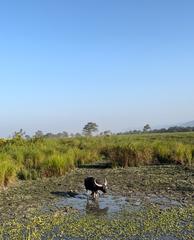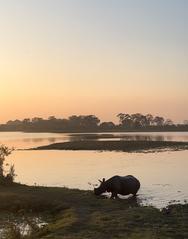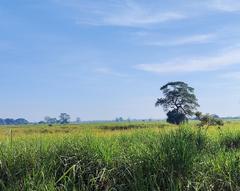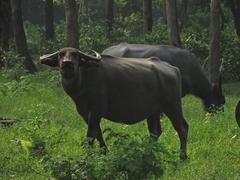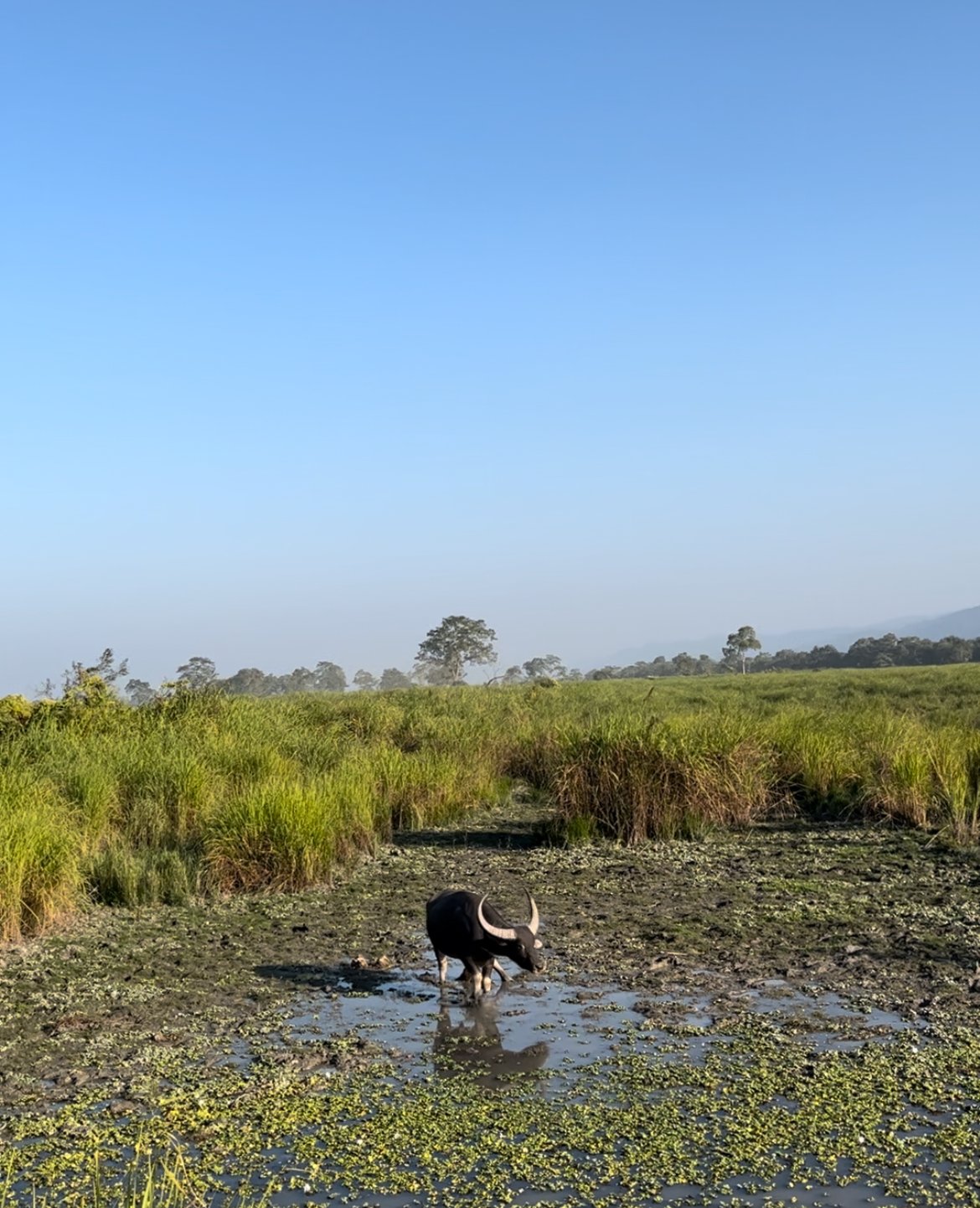
Kaziranga National Park Visiting Hours, Tickets, and Travel Guide
Date: 14/06/2025
Introduction to Kaziranga National Park: History and Significance
Kaziranga National Park, set in Assam’s Brahmaputra floodplains, is a UNESCO World Heritage Site acclaimed for its biodiversity and pioneering conservation. Established as a reserve forest in 1905, following Mary Curzon’s advocacy, Kaziranga evolved into a sanctuary for the largest population of Indian one-horned rhinoceroses, Bengal tigers, Asiatic elephants, and wild water buffalo. Over more than a century, Kaziranga’s conservation story has become a global model (Wikipedia; Sentinel Assam).
The park’s mosaic of alluvial grasslands, wetlands, and tropical forests offers a haven for wildlife and a window into Assam’s ecological and cultural heritage. The best time for visitors is November to April, with optimal safari opportunities and wildlife activity (kaziranganationalpark-india.com; Native Planet). Jeep and elephant safaris in four distinct zones provide immersive wildlife encounters, especially with the park’s famed rhinoceroses.
Kaziranga also reflects deep ties with local communities such as the Mising and Karbi peoples, whose traditions and livelihoods intertwine with the park. Ecotourism supports local employment and crafts, reinforcing the park’s socio-economic impact (Kaziranga National Park India; GeoJournal).
This detailed guide covers Kaziranga’s historical milestones, visiting hours, ticketing, travel tips, conservation efforts, nearby attractions, and best practices for responsible tourism. Whether you’re a wildlife lover, photographer, or cultural explorer, you’ll find essential insights for a memorable and sustainable visit (Kaziranga National Park).
Contents
- Historical Overview and Conservation Milestones
- Visitor Information (Hours, Tickets, How to Reach, Best Time, Safety)
- Safari Experiences (Jeep, Elephant, Birdwatching)
- Accessibility
- Nearby Attractions and Accommodations
- Special Events and Guided Tours
- Photography Tips
- Conservation Strategies and Community Involvement
- Ongoing Challenges and Future Directions
- FAQs
- Call to Action
Historical Overview and Conservation Milestones
Early Origins and Establishment (1904–1938)
Kaziranga’s protection began in 1904, when Mary Curzon, disturbed by the absence of rhinoceroses, urged conservation action. The area became Kaziranga Proposed Reserve Forest in 1905 (232 sq. km), later expanding to the Brahmaputra’s banks. By 1908, it was a Reserve Forest, and by 1916 a Game Sanctuary, gradually shifting from hunting to protection. All hunting ceased in 1926, and by 1938, Kaziranga opened for regulated tourism (Wikipedia; Kaziranga National Park India).
Transition to Wildlife Sanctuary and Legal Protections (1950–1974)
Post-independence, Kaziranga was renamed a Wildlife Sanctuary in 1950 to remove hunting associations. The Assam (Rhinoceros) Bill (1954) and Assam National Park Act (1968) brought strict anti-poaching and preservation laws. Kaziranga became Assam’s first national park in 1974, covering 430 sq. km (Kaziranga National Park; Sentinel Assam).
UNESCO World Heritage Site and Global Recognition (1985–2005)
UNESCO inscribed Kaziranga as a World Heritage Site in 1985, citing its biodiversity and conservation leadership. The park now protects two-thirds of the world’s Indian one-horned rhinoceroses, as well as tigers, elephants, and wild buffalo. Centenary celebrations in 2005 highlighted a century of conservation (Kaziranga National Park).
Expansion, Tiger Reserve Status, and Ongoing Conservation (2006–Present)
Kaziranga’s boundaries have expanded to buffer against Brahmaputra floods, with proposals adding over 450 sq. km. In 2006, it was declared a Tiger Reserve, furthering its role in landscape-level conservation. The 2018 census recorded 2,613 rhinos and over 500 bird species, including the endangered Bengal florican (National Parks Association).
Visitor Information
Visiting Hours
- Open Season: November 1 – April 30
- Closed: May – October (monsoon flooding)
- Hours: 6:00 AM – 5:00 PM (safaris have specific timings by zone; see below)
Ticket Prices
- Indian Nationals: INR 100–200
- Foreign Tourists: INR 2000–2500
- Safari Fees: Vary by type (jeep or elephant) and zone
- Booking: Online or at park gates; advance booking recommended during peak season
How to Reach Kaziranga
- By Air: Jorhat Airport (97 km), Guwahati Airport (217 km)
- By Train: Furkating Junction (97 km)
- By Road: Connected via National Highway 37; buses/taxis from Guwahati, Jorhat
Best Time to Visit
- Optimal Season: November–April (dry, pleasant, best for wildlife)
- Peak: December–March
What to Bring
- Neutral, comfortable clothing for safaris
- Binoculars and camera with zoom lens
- Sunscreen, hat, insect repellent, water, snacks
Safety Guidelines
- Adhere to park rules and guide instructions
- Remain inside vehicles on safari
- Avoid loud noises; do not disturb wildlife
Safari Experiences
Jeep Safari
- Available: All zones (Kohora, Bagori, Agaratoli, Burapahar)
- Timings: 7:00–9:30 AM and 1:30–3:30 PM
- Duration: 2–2.5 hours
- Booking: Advance preferred; 6 persons/jeep
Elephant Safari
- Zone: Bagori (Western Range) only
- Timings: 5:00–7:30 AM and 3:00–4:00 PM
- Duration: 1–1.5 hours
- Booking: Limited slots; arrive early
Birdwatching
Kaziranga is an Important Bird Area with over 480 species. Winter is best for migratory waterfowl; resident specialties include the Bengal florican and greater adjutant stork (Native Planet).
Accessibility
While accessibility is limited, some zones offer wheelchair-friendly safari vehicles and accessible accommodation. Advance arrangements with park authorities are advised.
Nearby Attractions and Accommodations
- Accommodation: Eco-lodges, government rest houses, and private resorts (mainly around Kohora and Bagori)
- Dining: Assamese and Indian cuisine at Rhino Café, Hornbill Restaurant, and Maihang Restaurant
- Nearby Attractions: Tea gardens (Jorhat), Majuli Island, Numaligarh Ruins, Panbari Reserve Forest, Assam State Museum (Guwahati)
Special Events and Guided Tours
- Guided Safaris: Both jeep and elephant
- Birdwatching Tours: Seasonal, led by local experts
- Cultural Events: Kaziranga Elephant Festival (Jan–Feb) with parades, music, and dance
Photography Tips
- Shoot during early morning or late afternoon for best light
- Use telephoto lenses for wildlife; avoid flash
- Respect animal space
Conservation and Community Involvement
Kaziranga’s success is built on strong law enforcement, anti-poaching patrols, and community engagement. Locals are employed as guides, drivers, and in hospitality, while eco-tourism and craft sales provide supplementary income. Community-based tourism and conservation education foster stewardship (GeoJournal; National Parks Association). Habitat corridors and flood management support wildlife during monsoons (Wikipedia).
Challenges and Future Directions
Kaziranga faces threats from poaching, habitat encroachment, development, and climate change. Annual flooding, while ecologically beneficial, poses risks to both wildlife and communities. Expansion of protected areas and enhanced community partnerships are vital priorities (Wikipedia).
Frequently Asked Questions (FAQ)
Q: What are the visiting hours of Kaziranga National Park?
A: 6:00 AM – 5:00 PM, November to April.
Q: How can I buy tickets for Kaziranga safaris?
A: Online via the official website or at park gates; advance booking is recommended.
Q: What is the best time to visit?
A: November to April, with December–March as the peak season.
Q: Are there accommodations inside the park?
A: Yes, including forest lodges, eco-resorts, and nearby hotels.
Q: Is Kaziranga accessible for differently-abled visitors?
A: Some accessibility features are available; contact authorities in advance.
Responsible Tourism and Cultural Sensitivity
- Support local businesses by buying crafts and using community-run guides
- Respect local customs, minimize waste, and avoid wildlife disturbance
- Participate in village tours and cultural events to enrich your experience
Planning Your Visit: Summary and Recommendations
Kaziranga is best visited from November to April, with peak wildlife activity and favorable conditions. Safaris are available in four zones, and tickets/permits should be booked in advance. Combine your wildlife adventure with visits to nearby cultural and historical sites for a well-rounded experience. Always follow park rules, support local communities, and practice responsible tourism for a meaningful and positive impact.
Visual and Interactive Resources
- View high-quality photos of the one-horned rhinoceros, Bengal tiger, and park landscapes on the official website.
- Interactive maps and virtual tours are available for trip planning.
- Images should include descriptive alt text such as “Indian one-horned rhinoceros in Kaziranga National Park” and “Sunrise over Kaziranga’s grasslands.”
Internal and External Links
References
- History of Kaziranga National Park, Wikipedia, 2024
- Kaziranga National Park India, 2024
- Discover Assam’s Pride: UNESCO World Heritage Sites, Sentinel Assam, 2024
- Kaziranga National Park Official History, 2024
- National Parks Association – Kaziranga National Park Overview, 2024
- Kaziranga Safari Timings and Online Booking Guide 2025, KazirangaNationalPark-India.com, 2025
- Know How Assam’s Kaziranga National Park Made History and Broke Records, Native Planet, 2024
- Kaziranga National Park Safari Zones and Visitor Guide, KazirangaNationalPark-India.com, 2024
- Kaziranga National Park Expansion Approved 2025, KazirangaNationalPark-India.com, 2025
- Community-Based Tourism and Conservation in Kaziranga, GeoJournal, 2024
- Best Time to Visit Kaziranga National Park, kipepeo.in
- The Best Time to Visit Kaziranga National Park for Wildlife Viewing, kazirangapark.com
- Kaziranga National Park in Assam: How to Plan Your Visit, stampedmoments.com
- Jungleciti House Kaziranga Responsible Tourism, jungleciti.com
Kaziranga National Park stands as a beacon of biodiversity, conservation, and cultural heritage in India. By planning responsibly and supporting local communities, your visit contributes to the ongoing preservation of this unique natural treasure.
